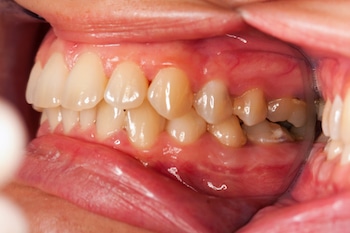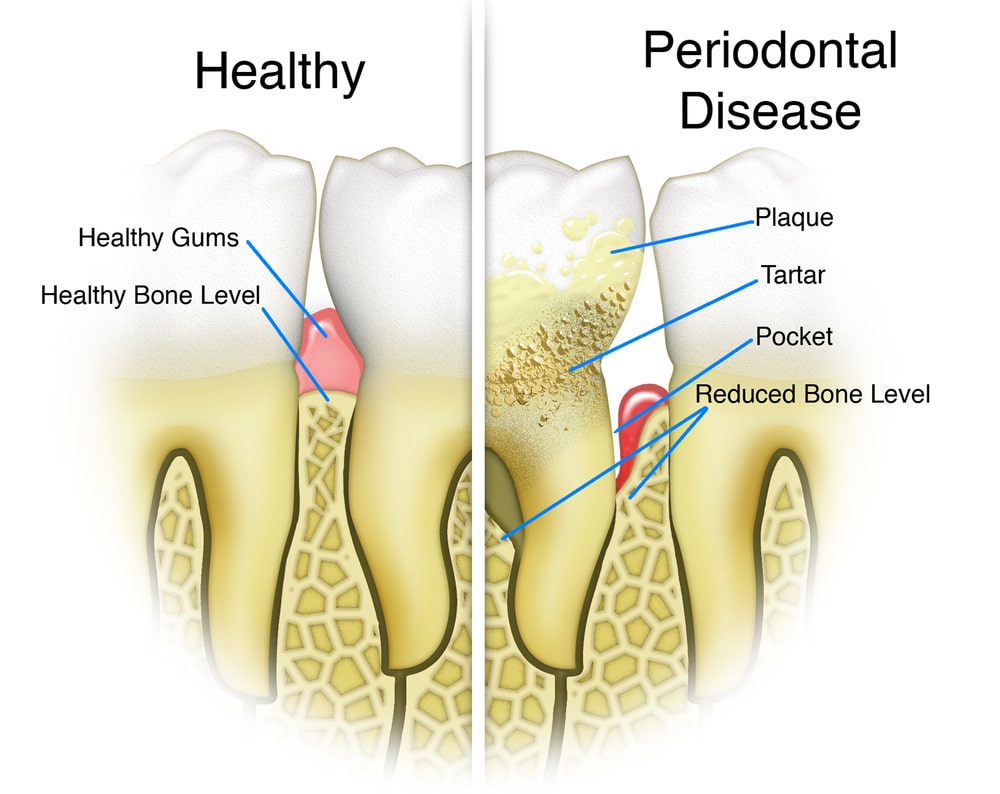
Gingivitis and periodontal disease are similar conditions that affect your gums. Understanding what each of these conditions is, how they happen, and how they can be prevented will help you keep your mouth healthy. Let’s take a look at gingivitis vs periodontal disease, the differences, and how you can tell if one of these is affecting you.
Gingivitis vs Periodontal Disease: What Are They?
Both gingivitis and periodontal disease are stages of gum disease. About half of men and one third of women over the age of thirty in the United States have some type of gum disease. Though gingivitis, an early stage of gum disease, is reversible, the effects are not reversible when it has progressed to periodontal disease.
What is Gingivitis?
Let’s start with gingivitis. What is gingivitis? Gingivitis is the earliest stage of gum disease and is characterized by inflammation of the gums. It is primarily caused by the buildup of plaque, a sticky film of bacteria that forms on teeth. While gingivitis is generally mild and reversible with proper oral care, neglecting it can lead to more severe forms of gum disease, including periodontal disease.
What is Periodontal Disease?
Periodontal disease, also known as periodontitis, is an advanced stage of gum disease that occurs when gingivitis is left untreated. It affects not only the gums but also the bones and tissues that support the teeth. Unlike gingivitis, periodontal disease is not fully reversible and often requires professional treatment to manage and prevent further damage.
Understanding Gingivitis
How Gingivitis Starts
Gingivitis begins when plaque accumulates on teeth and along the gumline. Plaque contains bacteria, such as Streptococci mutans and Streptococci sanguinis, that produce acid which creates holes in teeth (cavities) and irritates the gums, causing inflammation. These and other bacteria live in the sticky biofilm that accumulates in our mouths as we eat and drink. Brushing your teeth twice a day removes this biofilm and helps to prevent it from hardening into plaque.
However, your toothbrush can’t reach the spaces in between your teeth. Bacteria will collect and multiply in these areas, causing irritation to the gums. Not brushing or regularly flossing is the most common cause of plaque buildup, but other factors such as hormonal changes, smoking, and certain medications can also contribute.
Signs of Gingivitis
Common signs of gingivitis include red, swollen gums that may bleed easily when brushing or flossing. If you notice your gums bleed when you floss, this is the first sign of gingivitis. Bacteria are creating unbroken colonies between your teeth and attacking your gums, making them sensitive and causing them to bleed easily. This is one of the reasons dentists agree that flossing is important.
You might also notice persistent bad breath or a receding gumline. While gingivitis is usually painless, these symptoms indicate that action is needed to prevent further progression.
Preventing Gingivitis
Preventing gingivitis starts with maintaining excellent oral hygiene. Brush your teeth at least twice a day using fluoride toothpaste, floss daily to remove plaque from between teeth, and use an antimicrobial mouthwash if recommended by your dentist.
Regular dental checkups and professional cleanings are also essential for preventing plaque buildup and catching early signs of gum disease. Additionally, replacing at least some sugary beverages with water and some sugary snacks with vegetables can help fight gum disease. Avoiding tobacco and vaping can also significantly reduce your risk.
Understanding Periodontal Disease
 How Periodontal Disease Occurs
How Periodontal Disease Occurs
Periodontal disease or periodontitis develops when gingivitis progresses and the bacterial infection spreads below the gumline. This leads to the formation of pockets between the teeth and gums, where bacteria thrive. Over time, these pockets deepen, causing the gums and bone to deteriorate. Advanced periodontal disease can result in tooth loss if left untreated.
Signs of Periodontal Disease
Signs of periodontal disease include persistent gum inflammation, deep pockets around the teeth, receding gums, and loose or shifting teeth. Other symptoms may include pus between the teeth and gums, severe bad breath, and changes in how your teeth fit together when you bite. Periodontal disease may also contribute to systemic health issues such as heart disease and diabetes.
Preventing Periodontal Disease
While periodontal disease cannot be completely reversed, it can be managed and its progression slowed. Preventive measures include maintaining a consistent oral hygiene routine, attending regular dental visits, and undergoing deep cleanings such as scaling and root planing if recommended by your dentist.
Addressing risk factors such as smoking, stress, and underlying health conditions can also help prevent periodontal disease. For individuals with advanced cases, surgical treatments such as pocket reduction or bone grafts may be necessary to restore gum and bone health.
Understanding the differences between gingivitis vs periodontal disease and recognizing the signs can help you prevent them. Gingivitis and periodontal disease are both forms of gum disease, but they differ significantly in severity and treatment. If you’re experiencing any symptoms of gum disease, make an appointment with a BDG dentist today online or call 702-388-8888.


 How Periodontal Disease Occurs
How Periodontal Disease Occurs